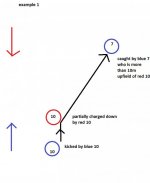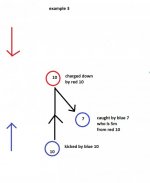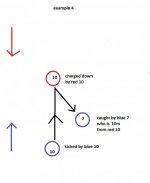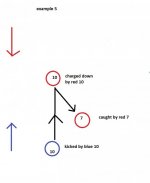So after trying to wrap my head around the unusual SA try against ENG from this weekend and reading up on Law 11 I am confused.
I have drawn 5 scenarios and I am curious what the correct call would be. The biggest confusion I have is regarding law 11.4(f) and how it applies to my examples 2, and 3
Law 11.4(f)states:
The 10-metre Law does not apply when a player kicks the ball, and an opponent charges
down the kick, and a team-mate of the kicker who was in front of the imaginary 10-metre
line across the field then plays the ball. The opponent was not ‘waiting to play the ball’ and
the team-mate is onside. The 10-metre Law applies if the ball touches or is played by an
opponent but is not charged down.
and Does the act of charging it down satisfy 11.3(c) and put everyone onside?
11.3(c) states:
Intentionally touches ball. When an opponent intentionally touches the ball but does not catch it, the offside player is put onside
For the example diagrams I drew assume that:
-The red and blue arrows indicate the direction the team is playing toward. The black arrow shows the path of the ball
-Blue #10 does not move or attempt to put anyone onside after kicking it.
-Red #10 charges down the ball(or partially charges it down) and then does not advance.
-In examples 2 and 3 Blue #7 does not have time to move out of the 10m zone and catches it immediately
-In example 5, Red #7 catches it immediately and does not have the chance to retreat behind Red #10





I have drawn 5 scenarios and I am curious what the correct call would be. The biggest confusion I have is regarding law 11.4(f) and how it applies to my examples 2, and 3
Law 11.4(f)states:
The 10-metre Law does not apply when a player kicks the ball, and an opponent charges
down the kick, and a team-mate of the kicker who was in front of the imaginary 10-metre
line across the field then plays the ball. The opponent was not ‘waiting to play the ball’ and
the team-mate is onside. The 10-metre Law applies if the ball touches or is played by an
opponent but is not charged down.
and Does the act of charging it down satisfy 11.3(c) and put everyone onside?
11.3(c) states:
Intentionally touches ball. When an opponent intentionally touches the ball but does not catch it, the offside player is put onside
For the example diagrams I drew assume that:
-The red and blue arrows indicate the direction the team is playing toward. The black arrow shows the path of the ball
-Blue #10 does not move or attempt to put anyone onside after kicking it.
-Red #10 charges down the ball(or partially charges it down) and then does not advance.
-In examples 2 and 3 Blue #7 does not have time to move out of the 10m zone and catches it immediately
-In example 5, Red #7 catches it immediately and does not have the chance to retreat behind Red #10





Last edited:





